
© 2006, 1999, 1978 Margaret L. Benner All rights reserved.
Before going on to compound and complex sentences, you should be thoroughly familiar with the simple sentence. Here is a small review.
a subject
a
predicate verb
a complete thought

Simple
sentence
=
Independent clause


Remember:
a simple
sentence (independent clause) consists of a
subject,
a verb,
and a complete
thought.
Now
this module will teach you about compound and complex sentences.
Sometimes two independent clauses (two simple sentences) can be put together to form another kind of sentence: the compound sentence.
There are three patterns one may use to link simple sentences into a compound sentence.
Pattern
#1:


for
and
nor
but
or
yet
so
If
put together into a compound sentence, the two simple sentences above would look
like any one of these:






(The
joining word or
was not used in this compound sentence since the resulting sentence would not
make sense.)
For, and, nor, but, or, yet, and so are joining words.
They are also called
coordinating
conjunctions because they join or coordinate two equal clauses.
One way to memorize them easily is to remember FANBOYS:

Now click on the link below to do exercise 1.
![]()
To
learn how to form a compound sentence like this, look at these simple sentences.


They
can be made into one compound sentence with a semicolon
alone between the two independent clauses.

The
semicolon
has more strength than the comma.
Thus, it can separate two independent clauses by itself; a comma cannot
separate two independent clauses unless it is followed by a coordinating
conjunction (FANBOYS).
Now click on the link below to do exercise 2.
![]()
Here
is a list of the most frequently used conjunctive
adverbs.
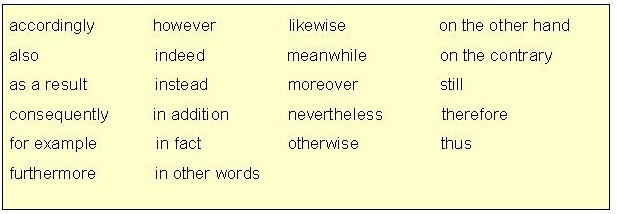


These two sentences can be combined into a compound sentence with a semicolon, appropriate conjunctive adverb, and comma.

Like
the coordinating conjunction, each conjunctive adverb has an individual meaning;
thus, you should use whichever one fits the sense of the sentence you are
writing.
For example, see how the sentence’s meaning changes when therefore is substituted for however:

Why
should you use compound sentences?
Sometimes it is better to use a compound sentence than a simple sentence. For example, you may use a compound sentence because you want a variety of sentences in your writing. In another instance, you may want to join two complete thoughts that are closely related in order to show your reader the relationship.
(For more information on compound sentences, click on this
link.)
Now click on the link below to do exercise 3.
To
form a compound sentence, remember these rules for constructing it:
1. an appropriate coordinating conjunction (FANBOYS)
and
place 
OR
2.
with a semicolon alone;

OR
3. with an appropriate conjunctive adverb (however, etc.), and
place a semicolon before the conjunctive adverb and a
comma after it.

TWO MAJOR ERRORS: COMMA SPLICES AND FUSED SENTENCES
This
section discusses two major errors
committed with compound sentences:
X
the
comma splice
and X
the
fused sentence
Please
read this section carefully so that you can recognize these errors and avoid
them in your writing.
ERROR
#1: THE COMMA SPLICE
Writers
make this error when they try to separate the two independent clauses in a
compound sentence with a comma alone.
A
comma is not a strong enough punctuation mark to separate the two independent
clauses by itself; thus, using it causes the clauses to be spliced
together.
Example of comma splice

We
can repair this comma splice in several ways:



The
sentence below is another example of a comma
splice.

We
repair it by correcting the punctuation.

In
each case above, we are forming a correct compound sentence by using patterns 1,
2, and 3 shown at the beginning of this module..
Example of a fused sentence

We
can repair a fused sentence the same way we repair a comma splice:
1.
Add an appropriate coordinating
conjunction (FANBOYS).

2. Place a semicolon between
the two clauses.


The
sentence below is another example of a fused
sentence.


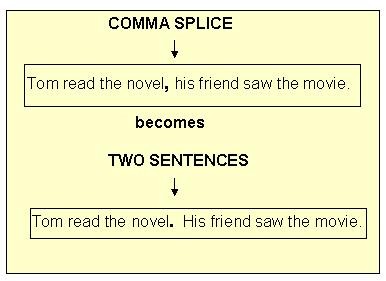
Now click on the link below to do exercise 4.
Besides the simple sentence and the compound sentence, there is one other basic
pattern
Note
the difference:
A simple
sentence = 1 independent clause
Here
is an independent clause (simple sentence):

It
contains a subject (Tom),
a verb (saw),
and a complete thought.
However,
look at the following clause:

Because
this group of words contains a subject-verb
core (friend-read),
it is a clause.
However,
because it does not express a complete
thought, it is NOT an independent clause.
We
call such clauses dependent
clauses because they depend
on attachment to other sentence elements to be a complete thought.
Here
is a list of words that begin dependent clauses.
They are called
subordinating conjunctions.
Become familiar with them.
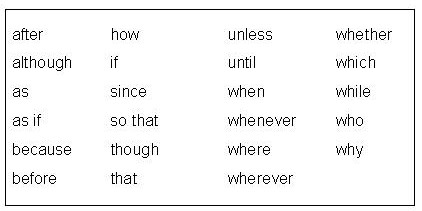
1. Independent clause followed by dependent clause

2.
Dependent clause followed by
independent clause

Each
sentence above is composed of two clauses – an independent clause and a
dependent clause.
By
attaching the dependent clause to an independent clause, we give the dependent
clause the additional meaning it needs to be a complete thought.
A
sentence composed of an independent clause and a dependent clause is called a COMPLEX
SENTENCE.
Two
basic patterns for the complex sentence are
1.
Independent clause dependent
clause.
2.
Dependent clause, independent
clause.
Punctuation
Rule:
Pattern #2 (dependent clause first) uses a comma between the clauses;
pattern #1 (independent clause first) uses no
comma between the clauses.
Here
are examples of each pattern above.
EXAMPLES
– Pattern #1
Independent
clause dependent clause
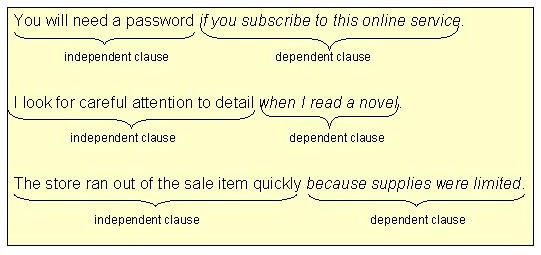
EXAMPLES– Pattern #2
Dependent clause, independent clause.
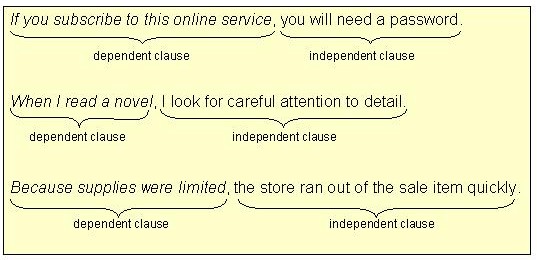
PUNCTUATION REMINDER: When a complex sentence begins with the dependent clause, place a comma between the dependent clause and the independent clause.
(For more information on this kind of dependent clause, click on this link.)
A
third pattern for complex sentences puts the dependent clause IN
THE MIDDLE of the independent clause.
EXAMPLE
A
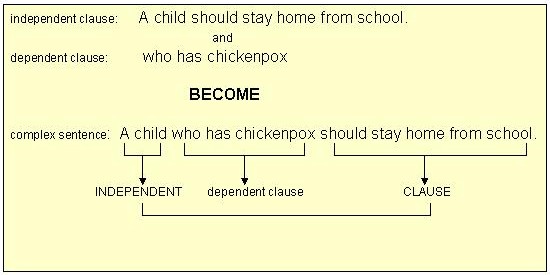
EXAMPLE
B
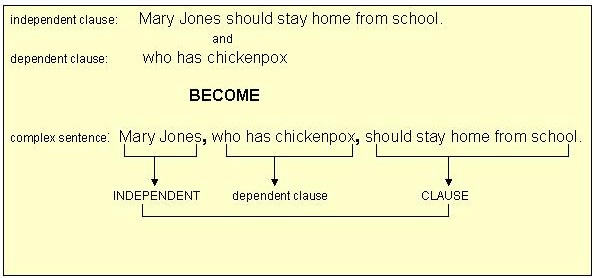
PUNCTUATION
NOTE:
In example A, no commas
separate the dependent clause from the independent clause.
A child who has chickenpox should stay home from school.
The dependent clause who has chickenpox is ESSENTIAL to the sentence. In other words, who has chickenpox is needed to identify which child should stay home from school.
BUT
In
example B, the dependent clause must
be separated from the independent clause with commas.
Mary Jones, who has chickenpox, should stay home from school.
Here,
the
dependent clause is NOT ESSENTIAL to
the sentence: the dependent clause is not
needed to identify the child – Mary
Jones.
For complex sentences using pattern #3, use commas to separate the dependent clause from the independent clause only if the dependent clause is not essential to the sentence's meaning.
If the dependent clause is essential, do not separate it from the rest of the sentence with commas.
(For more information on this kind of dependent clause, click on this link.)
Now click on the link below to do exercise 5.
A
single independent clause is a simple
sentence.
Combining
two
independent clauses creates a compound
sentence.
3 ways to combine:

Combining
a
dependent clause and an independent
creates a complex
sentence.
4 ways to combine:
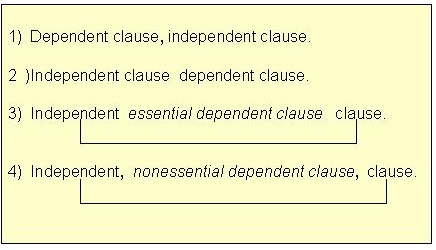
SUMMARY
However, it is also important to know these three kinds of sentences so that you can vary the sentence patterns in your writing.
Choose this best sentence pattern for each individual writing instance,
and thus use the written word to communicate most effectively.
Click on the link below to do the Post Test.